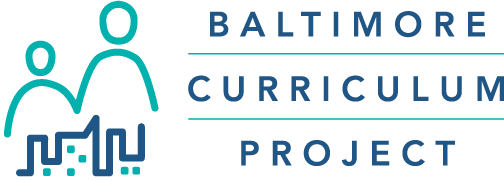What’s on the mind of all educators nationwide? The post-pandemic decline in students’ math ability. Last December, the National Assessment of Educational Progress reported that U.S. students are “failing to meet even the lowest level of achievement in math,” and the gap is widening.
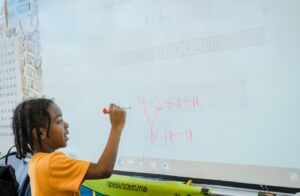 Closing this critical gap in mathematical skills, confidence, and success has been on the Baltimore Curriculum Project’s (BCP) radar for several years. Two years ago, guided by the expertise of our Math Curriculum Committee, we evaluated the different math curricula being used by the six BCP elementary and elementary/middle schools. While we have long been united in our BCP-wide use of the research-backed Direct Instruction program to teach reading, our schools did not have a concerted approach for a math curriculum.
Closing this critical gap in mathematical skills, confidence, and success has been on the Baltimore Curriculum Project’s (BCP) radar for several years. Two years ago, guided by the expertise of our Math Curriculum Committee, we evaluated the different math curricula being used by the six BCP elementary and elementary/middle schools. While we have long been united in our BCP-wide use of the research-backed Direct Instruction program to teach reading, our schools did not have a concerted approach for a math curriculum.
The Committee evaluated the efficacy of all BCP math curricula, visited other schools, and recommended Reveal Mathematics, the program by McGraw Hill. In 2024-2025, the following schools used Reveal Mathematics:
-
- City Springs Elementary / Middle School
- Frederick Elementary School
- Pimlico Elementary / Middle School
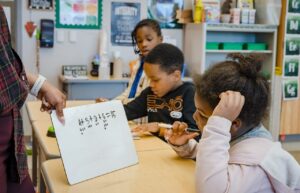 Our BCP model allows each school autonomy over its budget and some curriculum choices. Govans Elementary School and Wolfe Street Academy decided to introduce the program in coming years after finishing their final contract year with My Math, McGraw Hill’s precursor to Reveal Mathematics. A major factor in their decision was the strong growth and achievement with My Math, a harbinger for how the students will handle the transition to a new program. Hampstead Hill Academy continues to have exceptional math scores and is keeping a close eye on how the other schools fare with Reveal Mathematics.
Our BCP model allows each school autonomy over its budget and some curriculum choices. Govans Elementary School and Wolfe Street Academy decided to introduce the program in coming years after finishing their final contract year with My Math, McGraw Hill’s precursor to Reveal Mathematics. A major factor in their decision was the strong growth and achievement with My Math, a harbinger for how the students will handle the transition to a new program. Hampstead Hill Academy continues to have exceptional math scores and is keeping a close eye on how the other schools fare with Reveal Mathematics.
While we were rolling out our pilot math program this year, Baltimore City Public Schools also launched Reveal Mathematics in 30 schools. Its goal is to use the program systemwide by 2027.
BCP’s Reveal Mathematics Pilot Year
 I am delighted to report that our pilot year went very well. Two of our schools did better than ever before with mathematics growth on the NWEA MAP test:
I am delighted to report that our pilot year went very well. Two of our schools did better than ever before with mathematics growth on the NWEA MAP test:
• Frederick Elementary hit the 50th percentile for growth, well above how it ever scored before; and
• Pimlico Elementary/ Middle School was at the 55th percentile for growth compared to the school’s 2023-2024 45th percentile mark.
It’s equally important to note that these schools also saw student math achievement rise from the beginning to the end of the year. City Springs saw improvement over the year, but faced the challenge of a few teacher vacancies, which have been addressed for the coming school year to provide consistency in instruction. In the classrooms where there were experienced instructors at City Springs, math growth was in the 90% percentile and above.
One of the keys to our success is the BCP teacher coaching model. Our dedicated instructional coaches at each school provided support, training, and continual feedback to our teachers on how to best use Reveal Mathematics. We trained our teachers on Reveal Mathematics and increased the instructional coaches at each of the pilot schools. Pimlico hired two intervention teachers who also coached, Frederick added a full-time math coach, and City Springs hired more math coaching support.
Our math educators and coaches met regularly to discuss tweaks and insights, and the pilot program was a topic of discussion at our regular principals meeting. City Schools, our educational partner, also invited us to their weekly coaches’ meeting to discuss successes and challenges, a collaboration that truly benefited our teachers and coaches.
Meeting BCP’s Math Curriculum Needs
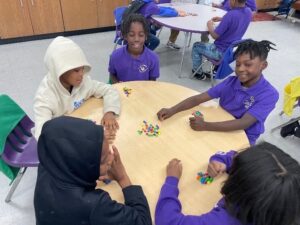 When we embarked on our evaluation of math curricula, we knew what we wanted: a program with clear instruction and cumulative review – both essential features for learning and retaining math skills. If the initial instruction isn’t clear, students come away with a hazy or incorrect grasp of the material. Students need regular cumulative review to master mathematical skills and practice what they’ve learned.
When we embarked on our evaluation of math curricula, we knew what we wanted: a program with clear instruction and cumulative review – both essential features for learning and retaining math skills. If the initial instruction isn’t clear, students come away with a hazy or incorrect grasp of the material. Students need regular cumulative review to master mathematical skills and practice what they’ve learned.
There are other benefits to Reveal Mathematics that embrace our mission and school communities:
- Impressive support for multi-language learners with all materials in English and Spanish and digital material in 128 other languages
- Data generation, print and digital, for real-time analysis of student strengths and weaknesses and to create small groups for targeted learning
- Online math program, ALEKS, that offers self-directed programs targeting students growth areas
- Flexibility and customization through each lesson’s PowerPoint and numerous tools that teachers can modify and incorporate to teach skills based on students’ needs and strengths.
A key benefit is being on the same page through training and support. Much of our focus this past year was helping teachers create the essential pieces of teaching a lesson and using the program’s baked-in flexibility.
Using Reveal Mathematics at BCP Schools: Success Stories
 The best proof of how Reveal Mathematics is helping our students are examples from our classrooms this past year.
The best proof of how Reveal Mathematics is helping our students are examples from our classrooms this past year.
At Frederick, Mikelle Horne, the school’s instructional coach, sees promising signs of growth, stating that, “Students across grade levels showed strong gains from fall to spring, with 1st grade standing out as a clear example.”
In 1st grade, the MCAP Growth Median Percentile reached the 72nd percentile, well above the national average, indicating that students made more progress than 72% of their peers nationwide. Achievement also rose significantly, increasing from the 37th percentile in winter to the 55th percentile in spring. This means students not only improved but also caught up in overall performance.
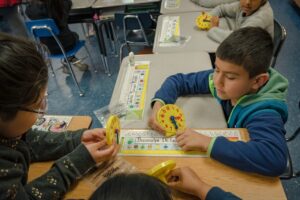 Ms. Horne further notes that “one contributing factor to this success is the way Reveal Mathematics helps students understand foundational concepts. For example, in Ms. Hill’s class, students used hands-on visuals and digital models to build and break apart numbers with base-ten blocks. Students who once struggled to differentiate tens and ones began confidently explaining that 82 is ‘8 tens and 2 ones,’ and could compare two-digit numbers using both symbols and reasoning. The scaffolded lessons, interactive practice, and spiral review all help reinforce key skills and contribute to the strong growth we observed.”
Ms. Horne further notes that “one contributing factor to this success is the way Reveal Mathematics helps students understand foundational concepts. For example, in Ms. Hill’s class, students used hands-on visuals and digital models to build and break apart numbers with base-ten blocks. Students who once struggled to differentiate tens and ones began confidently explaining that 82 is ‘8 tens and 2 ones,’ and could compare two-digit numbers using both symbols and reasoning. The scaffolded lessons, interactive practice, and spiral review all help reinforce key skills and contribute to the strong growth we observed.”
City Springs’ math team reports equally exciting benefits to student learning notes instructional coach Madeleine Phillips, who shared an example from Ms. Danielle Parker’s 3rd grade classroom about how Reveal Mathematics is increasing student-to-student dialogue.
She explains that each lesson begins with a ‘Be Curious’ activity where students examine and discuss images from the real world that relate to the skill or topic they are learning. For example, a picture of a rollercoaster might introduce the concept of adding and subtracting integers.
“Since most 3rd graders love to talk about rollercoasters, this gets their brains activated and builds momentum for new learning,” says Ms. Parker. “Student-to-student discourse not only stretches math abilities but also builds essential teamwork and communication skills.”
She further notes that one of her students who made great gains this year struggled with reading tasks but came alive in these math conversations. During an addition pattern lesson, he was able to explain to his partner and then the whole class how to identify even and odd numbers using number blocks by showing how blocks could be divided into two groups to determine whether a number is even or odd. Moments like these can be transformative for students’ math confidence and creativity.
What’s Next for Math Teaching and Learning for BCP?
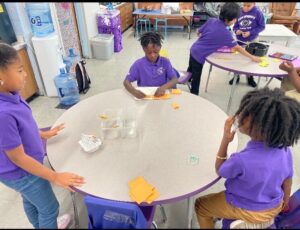 For the new school year, our math teams at each of the Reveal Mathematics BCP schools will continue to learn, train, and collaborate on the program to incorporate more of its tools and to use it to its full advantage. As Govans (SY 25-26) and, subsequently, Wolfe Street adopt the program, they will benefit from the experience and enthusiasm of their colleagues across the BCP network.
For the new school year, our math teams at each of the Reveal Mathematics BCP schools will continue to learn, train, and collaborate on the program to incorporate more of its tools and to use it to its full advantage. As Govans (SY 25-26) and, subsequently, Wolfe Street adopt the program, they will benefit from the experience and enthusiasm of their colleagues across the BCP network.
Our team of teachers, instructional coaches, and administrators is exceptional at identifying challenges, successes, and necessary improvements to our math instruction during the pilot year. Top of mind in every discussion were the standards our students need to reach and what they need to be successful as math learners.
